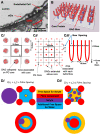John squire and endothelial glycocalyx structure: an unfinished story
- PMID: 36260209
- PMCID: PMC10542707
- DOI: 10.1007/s10974-022-09629-x
John squire and endothelial glycocalyx structure: an unfinished story
Abstract
John Squire did not only produce leading works in the muscle field, he also significantly contributed to the vascular permeability field by ultrastructural analysis of the endothelial glycocalyx. Presented here is a review of his involvement in the field by his main collaborator C.C. Michel and his last postdoctoral researcher KP Arkill. We end on a reinterpretation of his work that arguably links to our current understanding of endothelial glycocalyx structure and composition predicting 6 glycosaminoglycans fibres per syndecan core protein, only achieved in the endothelium by dimerization.
Keywords: Albumin; Glycosaminoglycan; Proteoglycan; Reflection coefficient; Vascular permeability.
© 2022. The Author(s).
Conflict of interest statement
The authors declare no competing interests.
Figures



References
Publication types
MeSH terms
Substances
Grants and funding
LinkOut - more resources
Full Text Sources

